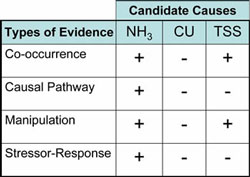Figure: Consistency of Evidence
Illustration
A candidate cause is strongly supported if all available types of evidence are consistently supportive. It is greatly weakened if all available types of evidence are consistently weakening. It is weakened if some types of evidence support and others weaken the candidate cause.
 Table 5-6. Consistency of Evidence. This chart depicts scores for several types of evidence across a few candidate causes. Evidence for NH3 is consistently supporting, evidence for CU is consistently weakening and evidence for TSS is inconsistent.
Table 5-6. Consistency of Evidence. This chart depicts scores for several types of evidence across a few candidate causes. Evidence for NH3 is consistently supporting, evidence for CU is consistently weakening and evidence for TSS is inconsistent.
Explanation of the Types of Evidence Illustrations
This description applies to each of the types of evidence illustrations. These illustrations provide graphic explanations of the types of evidence. They are somewhat abstract to convey that they are representative of the concept rather than illustrations of particular applications. The live fish (green and upright) represent unimpaired organisms, populations or communities of all types, not just fish. The dead fish (white and belly-up at the surface) represent all biological impairments, not just dead fish. The pipe represents all sources and the yellow effluent plume represents all causal agents (stressors), not just effluents or even chemicals. Clock faces represent the passage of time, not the particular time difference illustrated. Fish in beakers represent laboratory tests. Other graphic elements used in particular illustrations are explained in the caption.
